Author: UkuriaOC, Glassnode; Compiler: Deng Tong, Golden Finance
Summary
The fourth Bitcoin halving has occurred, reducing the annualized inflation rate of Bitcoin supply by 50%, decisively surpassing gold in terms of scarcity.
The growth rate in multiple network statistics is declining when measuring halvings, while the absolute values of these measures continue to climb to new ATHs.
The rise in spot prices and the decisive ATH breakthrough boosted investor profitability, which curbed the 50% drop in miner revenue from the beginning of the year.
Deflationary Supply
The Bitcoin supply curve is deterministic due to a clever mining algorithm called "difficulty adjustment". The protocol adjusts the difficulty of the Bitcoin mining process so that the average block interval remains around 600 seconds (10 minutes) no matter how much mining equipment is applied.
Every 210,000 blocks (roughly a 4-year period), a scheduled mining reduction occurs, with newly minted BTC decreasing by 50%. The fourth Bitcoin halving occurred over the weekend, with the block subsidy dropping from 6.25 BTC per block to 3.125 BTC, or about 450 BTC mined per day (for the 144 blocks mined).
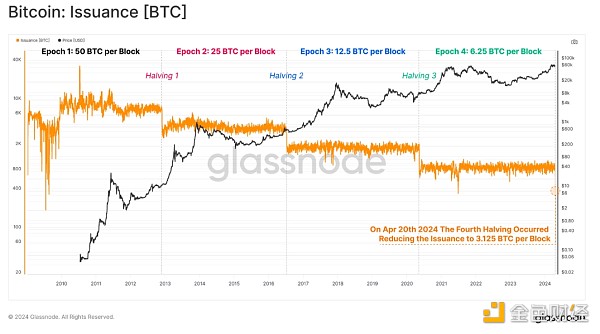
Entering the fourth halving, 19,687,500 BTC have been mined, equivalent to 93.75% of the terminal supply of 21 million BTC. Therefore, there are only 1,312,500 BTC left to be mined in the next 126 years, of which 656,600 (3.125%) have been mined in the current period. Interestingly, each halving represents a point:
The remaining supply percentage is equal to the new block subsidy (3.125 BTC/block vs 3.125% remaining).
50% of the remaining supply (1.3125 million Bitcoins) will be mined between the fourth and fifth halvings.
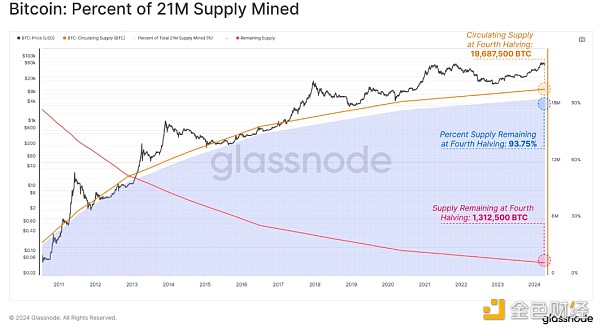
As the block reward is halved, the inflation rate is also halved approximately every 4 years. This makes the new annualized inflation rate of Bitcoin supply 0.85%, lower than 1.7% in the previous period.
The fourth halving also marks an important milestone in the comparison of Bitcoin with gold. For the first time in history, the steady-state issuance rate of Bitcoin (0.83%) is lower than that of gold (~2.3%), marking the historic handover of Bitcoin's title - becoming the scarcest asset.
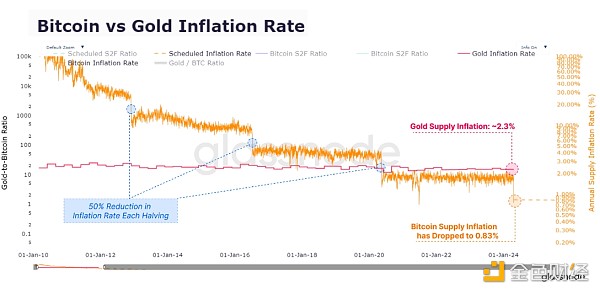
However, it is important to put the size of the halving in perspective. When assessing the relative impact of the halving on market dynamics, the amount of newly mined Bitcoin is still very small compared to global transaction volume within the Bitcoin ecosystem.
Mined volume accounts for only a small fraction of the on-chain transfer, spot, and derivative volume we see today, currently equating to less than 0.1% of total capital transferred and traded on any given day.
As a result, the impact of the Bitcoin halving on available transaction supply has been diminishing across cycles, not only due to the reduction in the number of Bitcoins mined, but also due to the increasing size of the assets and ecosystem surrounding it.
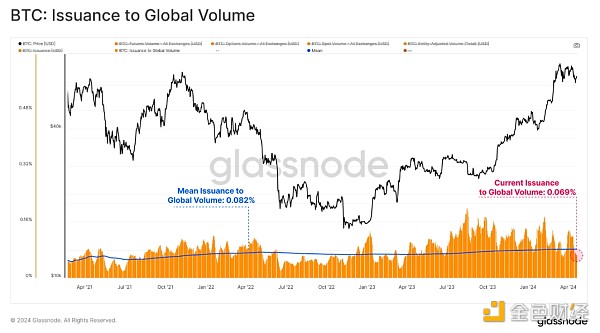
Grounded Expectations
The halving is a significant and well-publicized event, which naturally leads to heightened speculation about its impact on price action. It can be useful to balance our expectations with historical precedent and create loose bounds based on past performance.
Bitcoin’s price performance across halving periods has varied widely, and we believe that earlier halving periods were too different from today to be much of a guide. We do see diminishing returns and a weakening total drawdown effect over time, which is a natural result of the increasing size of the market and the scale of capital flows required to drive it.
Red: Epoch 2 price performance: +5315%, maximum retracement of -85%
Blue: Epoch 3 cost performance: +1336%, maximum retracement of -83%
Green: Epoch 4 cost performance: +569%, maximum retracement of -77%
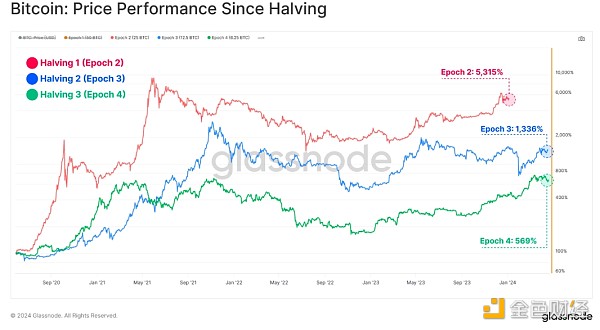
Evaluating the price performance from the cycle low until the halving, we note clear similarities between the 2015, 2018, and current cycles, all experiencing ~200% to ~300% growth.
However, our current cycle is the only one on record to decisively break above the previous ATH prior to the halving event.

Another perspective is to examine the market performance within 365 days after each halving. The performance in the second period is much greater, but we must consider that the dynamics and structure of today's market have changed significantly relative to the 2011-2013 period.
Therefore, the two most recent periods (3 and 4) provide a richer picture of the impact on asset size.
Red: Epoch 2 Price Performance: +7,258%, with a maximum retracement of -69.4%
Blue: Epoch 3 Price Performance: +293%, with a maximum retracement of -29.6%
Green: Epoch 4 Price Performance: +266%, with a maximum retracement of -45.6%
While the year following the halving event has been historically strong, there have also been some severe price declines along the way, ranging from -30% to -70%.
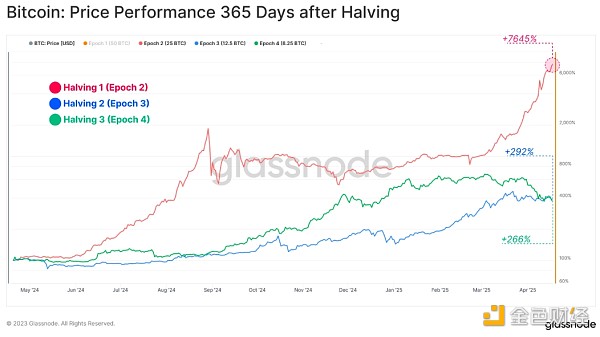
History Sometimes Resembles
During the 2022 bear market, a common narrative was that prices would never fall below the previous cycle’s ATH, which was then set at $20,000 in 2017. This was of course invalid, as prices fell more than 25% from the 2017 cycle high during widespread deleveraging at the end of 2022.
A similar narrative has been circulating recently, that prices cannot break a new ATH before the halving occurs. In March of this year, the narrative was invalidated again. The ATH we saw in March stemmed from historically tight supply (WoC-46-2023) and significant demand interest from new spot ETFs.
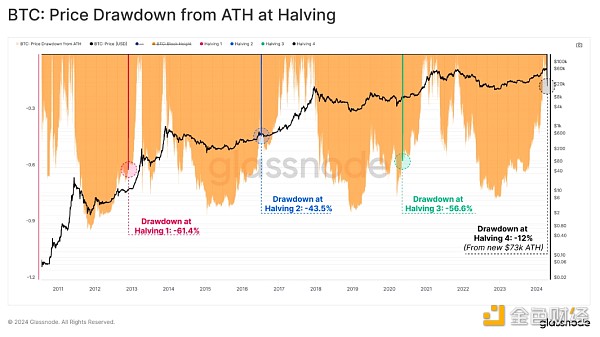
This price rally also had a significant impact on the unrealized profits held by investors. Currently, the unrealized profits held in the token supply are the largest (measured by MVRV) since the halving event.
In other words, as of the date of the halving, investors were holding the largest paper gains relative to their cost basis. With an MVRV ratio of 2.26, this means that the average unit paper gain for BTC is +126%.
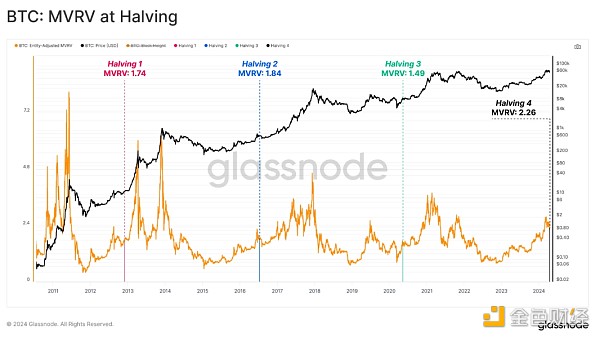
Fundamental Growth
In the previous section, we evaluated historical price performance centered on the halving. In the next section, we will turn our focus to the growth of network fundamentals, including mining security, miner income, asset liquidity, and settlement volume during the halving period.
Hashrate is a network statistic that assesses the collective "firepower" of the mining community. During the halving period, the growth rate of hashrate has slowed, but the absolute hashrate per second continues to grow and currently stands at 620 Exahash per second (equivalent to all 8 billion people on Earth completing 77.5 billion hashes per second).
Interestingly, hashrate is at or near new ATHs at each halving event, suggesting two scenarios could be happening:
The conclusion from both scenarios is that despite the 50% reduction in mining volume with each halving, the overall security budget is not only sufficient to maintain current OPEX costs, but also sufficient to stimulate further investments in both CAPEX and OPEX areas.
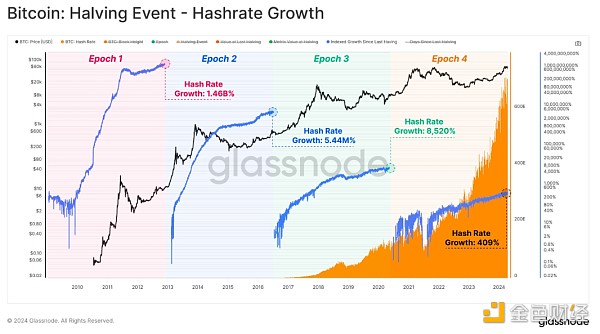
When measured in US dollars, the growth rate of miners' income is also declining, but the absolute scale is expanding. In the past 4 years, miners' cumulative income has reached a staggering 3 billion US dollars, an order of magnitude increase over the previous period.
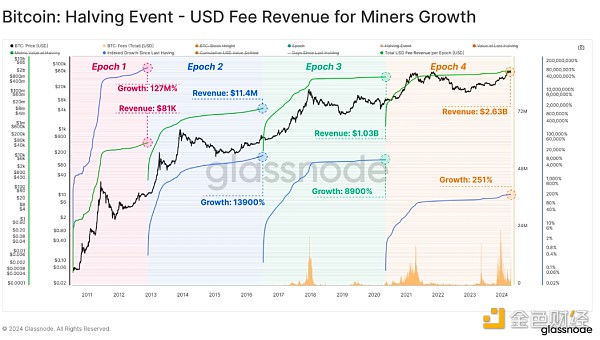
Realized cap is a powerful tool for measuring capital invested and stored in Bitcoin over time, and can be used to compare liquidity growth across cycles in USD terms.
By this measure, a total of $560 billion worth of USD value has been “stored” in Bitcoin. Realized cap is up 439% from the previous period, supporting the asset’s current $1.4 trillion market cap. It’s also worth noting that despite Bitcoin’s notorious volatility, bad headlines, and periodic drawdowns, capital continues to flow in.
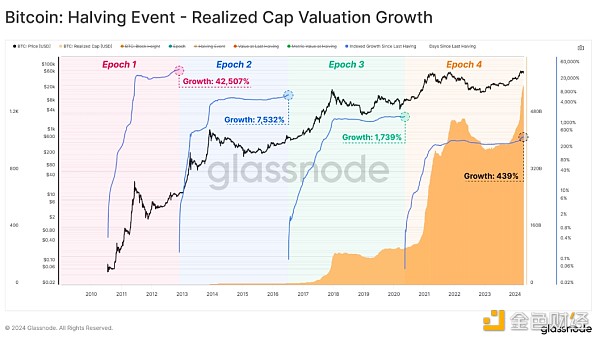
Finally, if we evaluate the volume of transactions settled during the halving period, we can see that over the past four years, the network has transferred and settled as much as $106 trillion in economic value. Now it’s important to note that this considers raw, unfiltered transaction volume and does not adjust for internal wallet management.
Nevertheless, every transaction is settled without an intermediary, highlighting the Bitcoin network’s incredible ability to handle value at scale.
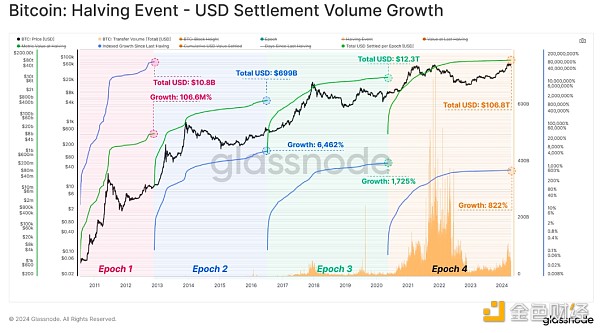
Summary
With the completion of the much-anticipated halving, the amount of each block mined has been halved, the scarcity of assets has intensified, and the scarcity of Bitcoin assets has decisively surpassed gold.
Comparing various periods, the growth of computing power, network settlement, liquidity, and miner income has all contracted. However, the absolute value of these indicators has increased by an order of magnitude, which is an incredibly impressive feat considering the market size.
It is worth noting that compared with previous halvings, the network profitability of market investors in all walks of life has increased significantly. This includes the base miner class, who have entered the halving with hashrate reaching ATHs, indicating sufficient security budgets to fuel both OpEx and CapEx needs.
 JinseFinance
JinseFinance
















